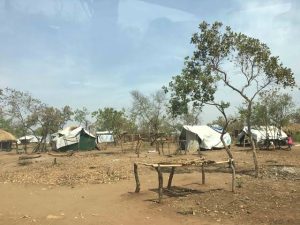Karamoja districts deploy teams at Kenya-Uganda border to monitor desert locusts
2 min read
Districts in Karamoja have deployed teams at the Uganda-Kenya border to monitor the movement of the deadly desert locusts.
It stems from reports that the swarm of the desert locusts is only about 60 kilometers from Amudat and Kaabong districts in Uganda. The locusts are wreaking havoc in West Pokot in Kenya.
Dr. Francis Inangolet Olaki, the Moroto District Production Officer told URN on Thursday morning the district has dispatched four experts led by the Entomology officer to keep watch at the border and report back to the District and Ministry of Agriculture, Animal Industries and Fisheries.
According to Dr. Olaki, the team will assess the situation on ground at the Uganda- Kenya border around Lokiriama and report to the Chief Administrative officer who shall issue a status report for action.
Other districts including Amudat, Kaabong and Kotido have also set up teams to monitor the desert locusts. Swaliki Waswa Masokoyi, the Amudat Chief Administrative Officer has confirmed the presence of the surveillance committee at the border.
He says although the desert locusts are not yet in Amudat district, there is high likelihood that they will arrive anytime. Government has been stocking insecticides in preparation of the desert locust invasion.
The Director of Extension Services Beatrice Byarugaba told the media in Kampala recently that the Ministry had requested for Shillings 11-billion for the contingency plan. She however said only Shillings 5 billion was available.
She also said Uganda was in close contact with the Desert Locust Control Organization based in Nairobi to fight the locusts. Government has been readying at least 2000 UPDF soldiers to carry out small scale spraying.
Today, MAAIF and the Office of the Prime Minister are holding a high government level crisis meeting on the locusts. The locust desert invasion was confirmed in Kenya last month but they have continued to advance towards the Ugandan border.PROMOTED CONTENT
What are desert locusts?
According to the UN Food and Agriculture Organizations (FAO) desert locusts are a collection of certain species of short-horned grasshopper family. The insects move in swarms and hang like shimmering dark clouds on the horizon as they scour the country.
The species of locusts have destroyed vegetation in Kenya and its moving towards Uganda . FAO officials say the locusts often travel in dense, crackling swarms, which can contain as many as 80 million locusts per square kilometer.
The desert locusts can live for up to five months depending on the weather and local conditions. They can lay eggs that can hatch in about two weeks with locusts maturing to adulthood in two to four months on average. If nothing is done to stop them, their numbers could grow 500 times by June.
FAO says the insects are so destructive and that they can destroy around 192 million kilograms of vegetation in about two days.
******
URN





